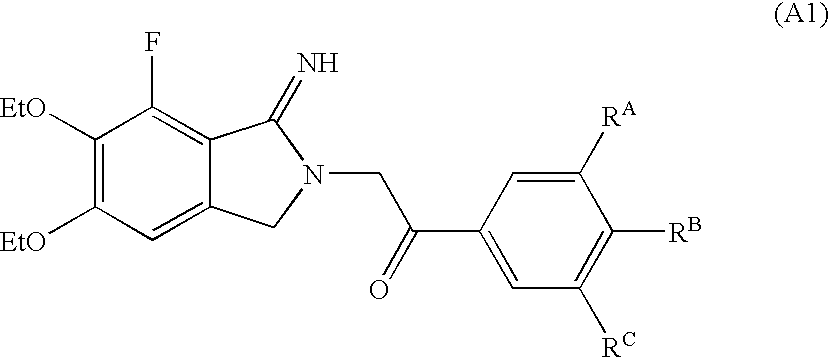Methods For Producing Isoindole Derivatives
a technology of isoindole and derivatives, applied in the field of methods for producing isoindole derivatives, can solve the problems of complex purification, low yield of compound of interest, cost, etc., and achieve low fire risk, high regioselectivity, and easy operation.
- Summary
- Abstract
- Description
- Claims
- Application Information
AI Technical Summary
Benefits of technology
Problems solved by technology
Method used
Image
Examples
preparation example 1
[0067]Production of 4,5-diethoxy-3-fluorophthalonitrile
[0068]A mixture of 1,2-dibromo-4,5-diethoxy-3-fluorobenzene (137.0 g, 0.401 mol, content: 81%), copper cyanide (107.5 g, 1.200 mol) and 1,3-dimethyl-2-imidazolidinone (600 mL) was subjected to nitrogen substitution under reduced pressure, then heated and stirred at 130° C. for 17 hours and at 140° C. for four hours under nitrogen atmosphere.
[0069]After the reaction mixture was cooled to room temperature, N,N-dimethylformamide (600 mL), toluene (1.2 L) and concentrated aqueous ammonia (1.2 L) were added thereto, and the layers were separated. The resultant organic layer was washed by adding N,N-dimethylformamide (411 mL) and concentrated aqueous ammonia (800 mL). The organic layer was further washed sequentially with a 25% aqueous solution of ethylenediamine (1.2 L), 1N hydrochloric acid (1.2 L), and water (1.2 L), filtered through activated carbon, and concentrated at 50° C. under reduced pressure to give a yellow sherbet-like r...
example 1
Production of 5,6-diethoxy-7-fluoro-3H-isoindol-1-ylamine
[0070]
[0071]A mixture of 4,5-diethoxy-3-fluorophthalonitrile (100 g, 0.427 mol) produced in Preparation Example 1, methanesulfonic acid (36 mL, 0.555 mol), 20% palladium hydroxide-carbon (12.5 g, 50% hydrate) (20% palladium hydroxide-carbon catalyst (wet), Kawaken Fine Chemicals Co., Ltd.) and 1,2-dimethoxyethane (500 mL) was stirred at 7° C. under hydrogen atmosphere (1 MPa) for 27 hours. After water (1 L) was added to the reaction mixture, insoluble matter was filtered off, and the residue was washed with water (500 mL).
[0072]The filtrates were combined, a 5N aqueous solution of sodium hydroxide was added until the pH reached 5.4, and the solution was stirred at room temperature for 18 hours. After toluene (500 mL) and ethyl acetate (100 mL) were added thereto, 5N hydrochloric acid was added until the pH of the aqueous layer reached 3.7, and the layers were separated. After ethyl acetate (500 mL) was added to the resultant a...
example 2
Production of 56-diethoxy-7-fluoro-3H-isoindol-1-ylamine sulfate
[0073]
[0074]A mixture of 4,5-diethoxy-3-fluorophthalonitrile (2.34 g, 10 mmol) prepared in Preparation Example 1, sulfuric acid (0.56 mL, 10 mmol), 20% palladium hydroxide-carbon (0.59 g, 50% hydrate) (20% palladium-carbon powder, palladium hydroxide type (hydrate), N.E. Chemcat Corporation) and 1,2-dimethoxyethane (23 mL) was stirred at −23° C. under hydrogen atmosphere (atmospheric pressure) for 29 hours. After insoluble matter in the reaction mixture was filtered off, the residue was washed with methanol (23 mL), and the combined filtrate was divided into five equal portions. To one of them, triethylamine (0.14 mL, 1 mmol) was added, and the mixture was stirred at 60° C. for three hours and concentrated at 40° C. under reduced pressure. Methanol (2.3 mL) and 1,2-dimethoxyethane (6.9 mL) were added to the residue, then sulfuric acid (0.11 mL, 2 mmol) was added on ice, and the mixture was stirred. Precipitated crystals...
PUM
| Property | Measurement | Unit |
|---|---|---|
| Fraction | aaaaa | aaaaa |
| Fraction | aaaaa | aaaaa |
| Fraction | aaaaa | aaaaa |
Abstract
Description
Claims
Application Information
 Login to View More
Login to View More - R&D
- Intellectual Property
- Life Sciences
- Materials
- Tech Scout
- Unparalleled Data Quality
- Higher Quality Content
- 60% Fewer Hallucinations
Browse by: Latest US Patents, China's latest patents, Technical Efficacy Thesaurus, Application Domain, Technology Topic, Popular Technical Reports.
© 2025 PatSnap. All rights reserved.Legal|Privacy policy|Modern Slavery Act Transparency Statement|Sitemap|About US| Contact US: help@patsnap.com



